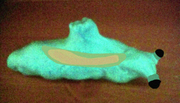No edit summary Tag: rte-source |
(Adding categories) Tag: categoryselect |
||
| (2 intermediate revisions by one other user not shown) | |||
| Line 1: | Line 1: | ||
| − | [[File:Stink_bomb_slug.png|thumb|A stink bomb slug in a greenhouse of Australia.]]Also known as the stink slug, a cannon backed slug, or a skunk slug, a stink bomb slug is a species of slug native to Australia, but was introduced accidentally to United States by humans. They are about the size of a common garden slug of California. They mainly feed on decaying vegetation, as well as fruits, vegetables, grass, leaves, shrubs, mosses, lichen, and mushrooms (even poisonous ones due to their strong immune systems). Unlike most other slugs and just like the [[Blueberry Slug|blueberry slug]], they have heat-proof thick skin, which helps keep the slugs alive and healthy, even in the hottest days, so they are commonly seen in fields and other places even if they're in the hot environment. They are similar to other slugs, but has a cannon-shaped appendage on its back, which can squirt out burning foul-smelling acid if threatened, hence their name, which can irritate a human's eyes, nose, and mouth. In the U.S., the stink bomb slug is considered as among the [[List of globally invasive species|100 worst invasive species]]. |
+ | [[File:Stink_bomb_slug.png|thumb|A stink bomb slug in a greenhouse of Australia.]]Also known as the stink slug, a cannon backed slug, or a skunk slug, a stink bomb slug is a species of slug native to Australia, but was introduced accidentally to United States and UK by humans. They are about the size of a common garden slug of California. They mainly feed on decaying vegetation, as well as fruits, vegetables, grass, leaves, shrubs, mosses, lichen, and mushrooms (even poisonous ones due to their strong immune systems). Unlike most other slugs and just like the [[Blueberry Slug|blueberry slug]], they have heat-proof thick skin, which helps keep the slugs alive and healthy, even in the hottest days and driest days, so they are commonly seen in fields and other places even if they're in the hot environment. They are similar to other slugs, but has a cannon-shaped appendage on its back, which can squirt out burning foul-smelling acid if threatened, hence their name, which can irritate a human's eyes, nose, and mouth. In the U.S. and UK, the stink bomb slug is considered as among the [[List of globally invasive species|100 worst invasive species]]. |
<div style="float:right;"> |
<div style="float:right;"> |
||
| Line 27: | Line 27: | ||
[[Category:Invasive Species]] |
[[Category:Invasive Species]] |
||
[[Category:Invasive Species On Earth]] |
[[Category:Invasive Species On Earth]] |
||
| + | [[Category:Custom Non-Domestic City Animals]] |
||
Latest revision as of 04:01, 21 May 2017

A stink bomb slug in a greenhouse of Australia.
Also known as the stink slug, a cannon backed slug, or a skunk slug, a stink bomb slug is a species of slug native to Australia, but was introduced accidentally to United States and UK by humans. They are about the size of a common garden slug of California. They mainly feed on decaying vegetation, as well as fruits, vegetables, grass, leaves, shrubs, mosses, lichen, and mushrooms (even poisonous ones due to their strong immune systems). Unlike most other slugs and just like the blueberry slug, they have heat-proof thick skin, which helps keep the slugs alive and healthy, even in the hottest days and driest days, so they are commonly seen in fields and other places even if they're in the hot environment. They are similar to other slugs, but has a cannon-shaped appendage on its back, which can squirt out burning foul-smelling acid if threatened, hence their name, which can irritate a human's eyes, nose, and mouth. In the U.S. and UK, the stink bomb slug is considered as among the 100 worst invasive species.
| Stink bomb slug |
|---|
|
